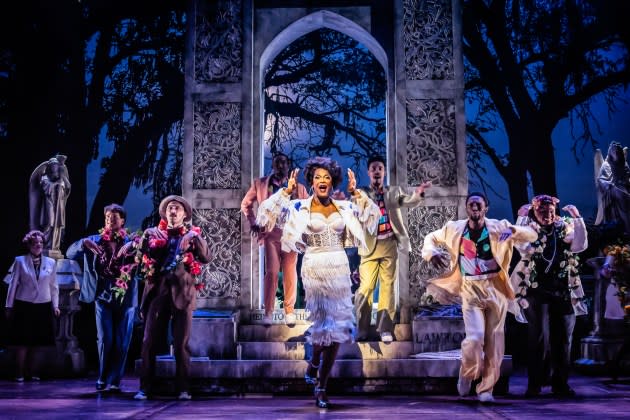‘Midnight in the Garden of Good and Evil’ Review: Musical Adaptation is a Promising, Boldly Unconventional Retelling Anchored by Standout Performances

In the admirably bold, unconventionally self-aware new stage musical version of John Berendt’s 1994 blockbuster bestseller “Midnight in the Garden of Good and Evil,” transgender icon The Lady Chablis emerges from being one of many eccentric ensemble characters in the Savannah-set book (and the 1997 Clint Eastwood-directed film, in which she appeared as herself) into the full-on spotlight. In fact, at the end of the first act in Taylor Mac’s script, J. Harrison Ghee’s intensely entertaining Lady Chablis steps in front of the shooting scene that formed the storytelling spine of both book and film, alarmed that attention may stray from her starring role: “Don’t look at the True Crime,” she directs us. “Don’t look at the white man who shot the hottest piece of ass in town.” The intervention works, perhaps a bit too well, in what is a musically and choreographically diverse adaptation — filled with diverting performances, but also overly diverted in its approach to the beloved title.
Taken purely on its own terms, the musical (now premiering at the Goodman Theatre in Chicago) has an abundance of riches and certainly gets off to a great start. In the atmospheric Bonaventure Cemetery, voodoo priestess Minerva (Brianna Buckley) summons the town’s ghosts and we immediately become aware of the split nature of the past. Tom Hewitt, as the antiques dealer Jim Williams — white, rich, gay and therefore both insider and outsider — then proceeds to welcome the writer (that’s us, the audience) to town with a cocktail offer, delivering some of the most perfect opening lyrics of what is likely composer Jason Robert Brown’s best score to date: “Raise your glass and sing a high hosanna/You who pine for fine Americana./Let me welcome you to sweet Savannah./What a lovely place to die!”
More from Variety
'Parade' Review: Ben Platt Stuns in a Powerful Broadway Production of an Essential American Musical
'Mr. Saturday Night' Review: Billy Crystal Brings the Laughs in His New Broadway Musical
But Jim doesn’t remain the lone host for long, nor is the nostalgia allowed to linger. Ghee enters quickly as the competing co-host, promising the writer (remember, that’s us!) a different take: “I got lots of secrets here. I’ll tell ‘em!/Hundred fifty years of ghosts, just smell ‘em! If your favorite aunt is Antebellum,/What a lovely place to die!”
They’re both great hosts. It’s easy to get immersed in Ghee’s extraordinary performance — an extended lounge act that showcases a triple threat performer (and Tony winner for “Some Like It Hot”) at the top of their game, able to break the fourth wall with natural ease and move us into and out of a story that doesn’t worry much about linear time.
And Hewitt, as the eventual criminal defendant of what, in the original version, was part suspenseful legal thriller, delivers a properly complex Jim Williams, in a love-hate relationship with the young Danny Hansford (an excellent Austin Colby), whom he shoots, possibly in self-defense. Hewitt has some amazing highs here, particularly as Jim is quite literally haunted by Danny – his song about Danny and his beloved Camaro, “What a Ride,” has both a surreal quality and a genuine longing.
But throughout, it seems as if The Lady Chablis, Jim, and possibly Danny, are the only actual characters in a story that became so popular because of its population of eccentrics. Some significant figures are just cut completely, others reduced to a quirk, and others, in the case of the society gossips, turned into a comic chorus: genuinely funny (Sierra Boggess is a hoot as a racist real estate snoot) but also too easy of a punching bag. Yes, it’s expected, and welcome, that the counter-cultural Mac (“A 24-Decade History of Popular Music,” “Hir”) is drawn naturally to the outsiders, but for a story that aspires to some depth, the racism of the decaying southern aristocracy shouldn’t be dismissed as just comic relief (particularly when Ghee provides all that relief we need already).
The other major problem here is that the effort to de-centralize the true crime component goes too far, summing up Jim’s four trials with a humorous song and a set of cue cards. There are genuine twists and turns in this tale, and this version of “Midnight” needs some of that to feel like it is more than just lingering. As is, the show has four different endings, and though two are great and two are also good, it’s a symptom that the whole lacks an underlying cohesion.
All that said, there’s real hope that Mac and Brown (“Parade,” “The Last Five Years”) can shape this into an extraordinary piece, given that even with all its raw edges it delivers a lot of satisfaction already and its unique, and modern, take on Savannah does bring currency. Director Rob Ashford has brought the world believably to life, and all the design work here is lovingly detailed and memorable, particularly set designer Christopher Oram’s reduced exterior version of Jim’s house, which becomes a character when other humans don’t.
Now that Mac has performed his always-expected deconstruction, and Brown has crafted a slew of strong and remarkably varied songs, a touch of restoration of the original characters and storytelling suspense would lift it both artistically and commercially.
Best of Variety
Sign up for Variety’s Newsletter. For the latest news, follow us on Facebook, Twitter, and Instagram.

